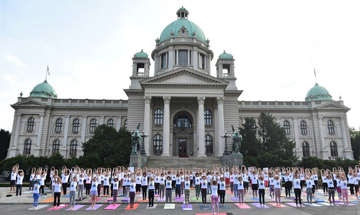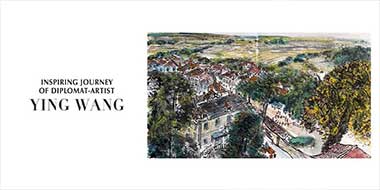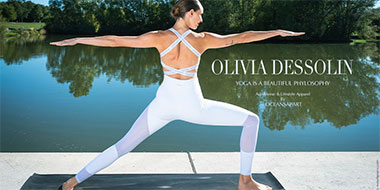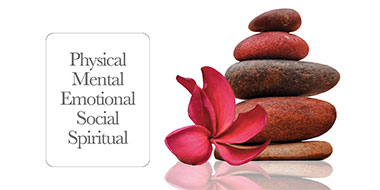YOGA HAS BEEN AROUND FOR THOUSANDS OF YEARS...!
“Breathing is the very essence of life and the first thing we do when we enter this world and the last thing when we depart.”

Yoga is both mental and physical. The numerous health benefits of yoga continue to be more and more widely known. Many of us would like to stay active but are not quite sure which physical activity would suit us best. The most popular form of yoga being practiced in the western world is Hatha Yoga. Its primary goal is to concentrate on physical health and mental well being. The physical exercises practiced in Hatha Yoga are called "Asanas" which are beneficial for muscles joints and the interregnal organs. They are excellent in improving posture and carriage. Hatha Yoga employs breathing techniques (Pranayama) to maintain and balance your life force or energy achieved through the control of respiration. It helps to restore physical, mental, emotional, and spiritual health.
“Breathing is the very essence of life and the first thing we do when we enter this world and the last thing when we depart.” “Vairagya” is the teaching of and exploration of non-attachment..., with a balanced mind and an attitude of non-attachment we can approach the situations of life.
Breathing is the very essence of life and the first thing we do when we enter this world and the last thing when we depart.
Ivana Lončar and husband Dragan Lončar from the Vidya Yoga School are celebrity yoga teachers living in Belgrade Serbia. We are pleased to interview Ivana Lončar, to discuss her perspective on yoga and body image, common assumptions about yoga, self-acceptance, and the numerous health benefits of yoga. Ivana is a health and wellness leader within her community.
FOLLOW US:
IVANA LONČAR
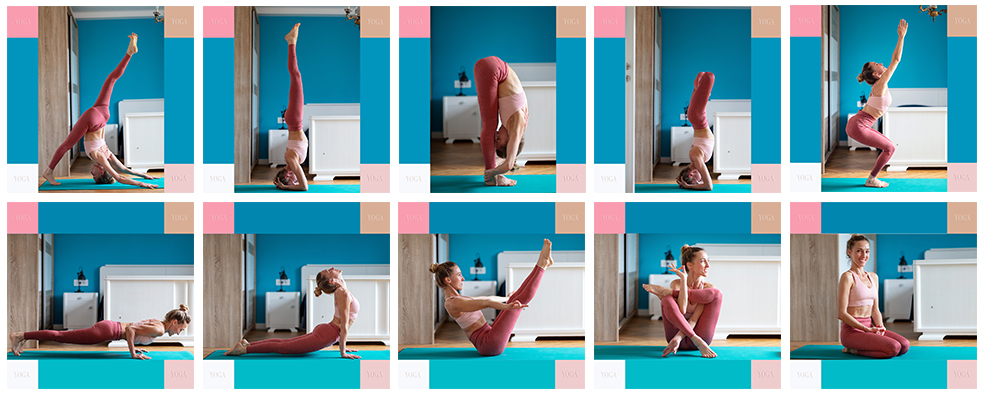 Ivana Lončar - Gallery of Yoga Positions
Ivana Lončar - Gallery of Yoga PositionsPhotography - Zoran Mircetic
TAP TO VIEW FULL-PAGE GALLERY
What type of yoga do you teach?
I teach Classical Hatha Yoga. The style I teach, in terms of the level of difficulty and the exercises, is similar to the BKS Iyengar style. The practitioners stay in the asanas a bit longer, conscious of their breathing, and with the obligatory engagement of the Mula Bandha. They are also encouraged to hold isometric contractions of the transversus abdominis muscle (below the navel), to preserve the integrity of the lumbar spine in demanding asanas.
In my asana exercise program, I put a lot of emphasis on strengthening and stretching the deep back muscles. The practice has shown that due to the sedentary urban living conditions, the back muscles are weakened to such an extent that spinal problems become inevitable. Weak abdominal muscles lead to disruption of the overall body statics which ends in chronic pain and musculoskeletal overload.
That is why I give priority to the extensions in my exercise program and why I balance them out with flexions, which means that both agonist and antagonist muscles stretch. That is how we achieve an equilibrium.
Every Hatha Yoga class consists of stretching exercises, flexions, and groin stretching (stretching the adductor in the hip joint), inversions, torsions and ends with yoga relaxation (yoga nidra). Simultaneously with the detailed instructions on how to get into a posture, hold it and get out of it safely, the practitioners are also instructed how to perform yogic breathing during at the same time, which provides the full benefits of a particular yoga posture.
How did you get into meditation and yoga?
always been physically very active. When I was very young I went to ballet lessons, to dance school, I practiced handball and went swimming (which is still a great love of mine). I loved trying new things and sports. I did Tae Bo, I ran, I went hiking. My yoga story began in 1999 when I was 18 and was the third grade in High School. I remember that one day at school, during the big break I started talking to a friend about yoga. We were both curious to find out what it was really about and decided then and there to take our first class together. And so we did, we liked it and continued taking the classes together. Later, she moved to another continent, and I kept going to those yoga classes. Even my dad got interested, so we went together for a while. I remember the first time that I learned to say the Om mantra. It was a bit strange and funny to me. Today, in the classes I teach, I see young girls come with their friends to see what this yoga is all about, just like I did years ago, and they giggle and smile as sweetly as I used to. I find it adorable. And like me so many years ago, they keep coming back for more. They enjoy the experience of practicing yoga postures, but they also enjoy the relaxation.
After a while, I could see from my own personal experience how much the regular practice of yoga can do to improve the fitness levels of athletes and help them with developing their technique, whichever sport is in question. Yoga inspired me so much that my graduation theses at the Sports Academy was the “The Application of Yoga Techniques in the Swimming Sports Training System”.
Two years after my first yoga class, at a seminar I heard about by chance, I first met my husband, the famous yoga teacher, Dragan Lončar (Swami Srividyananda). After that seminar, I went to practice at his yoga studio. After practicing for a few years, I took the YTTC at his Vidya Yoga School and graduated in 2007. After that, I first became an assistant teacher and then a yoga instructor at the Vidya Yoga School. I am most grateful to him for sharing his great knowledge of this amazing discipline with me and the others. I've been with the School for 13 years now, and together with my husband, who is both my greatest teacher and my best friend, we run Vidya Yoga (The Yoga of Knowledge) Yoga School. www.vidyayoga.net
My husband's spiritual name, which he received from one of the most famous Indian gurus of our times Swami Satyananda, is Srividyananda, which means sacred knowledge. That is actually how our Yoga School got its name. We believe that it is important for a person when they do something to understand why and how.
In addition to regular yoga classes, our school is also engaged in training yoga instructors. Dragan also teaches meditation courses and holds numerous public lectures. For the last 12 years, we have also been organizing active summer yoga vacations on the beautiful islands off the Croatian coastline.
As for my spiritual practice, I follow the path of Karma Kagyu of Tibetan Buddhism. (Vajrayana). My spiritual master is Karmapa Trinley Thaye Dorje. Mahayana is a Buddhist concept that emphasizes the need to develop compassion - Karuna which comes naturally to me and in it, found my refuge. Another important aspect of Tibetan Buddhism is Wisdom - Prajna, the ability to understand correctly.
Compassion and wisdom come naturally from one another. Whenever I am able to join my husband and close friends, I go for initiations and satsangs of this great enlightened Lama. They are usually held in the Tibetan monasteries mostly in southern France, always surrounded by beautiful nature.
Such experiences are always very deep and inspiring, special, and difficult to describe in words.
What are the benefits of practicing yoga and meditation regularly?
Here are ten reasons to do yoga. This list, based on clinical trials by teams of physicians concerned with the prophylactic and therapeutic values yoga, was once compiled by one of the most renowned yoga teacher associations in the world.
- Relieves stress. Yoga relieves us of the physical effects of stress that are accumulated in the body through relaxation and reduction in cortisol levels. This is complemented by the positive effects of reducing high blood pressure and heart rate, improving digestive function and strengthening the immune system, reducing symptoms of anxiety, depression, dizziness, asthma, and insomnia.
- Reduces pain. Studies have shown that yoga postures - asanas, as well as meditation (or a combination of these two) reduce pain in cancer patients, and those with multiple sclerosis, autoimmune diseases, arthritis, back pain, neck pain, and other chronic conditions.
- Better breathing. Yoga teaches us to breathe properly. Light and deep breathing enhances vitality and lung function and facilitates relaxation.
- Flexibility. Yoga gives you a more supple body, greater mobility, better movement coordination and reduces joint pain.
- Gives strength. Yoga postures activate every muscle, from head to toe, thus strengthening the entire body. They also reduce muscle tension.
- Regulates body weight. Even very light exercises affect the level of cortisol in the body, burn more calories faster and reduce stress, which accelerates weight loss. Yoga encourages a healthy diet and helps create healthy habits and confidence.
- Promotes circulation. It stimulates blood circulation and increases the oxygenation of cells in the body.
- Cardiovascular improvements. Light yoga exercises can improve cardiovascular fitness by reducing heart rate, increasing endurance as well as increasing the level of oxygen that is brought into the body by yogic breathing techniques.
- Better body posture. Yoga repairs and corrects improper posture while standing, walking, or sitting, which releases tension and discomfort.
- Develops a sense of the present moment. We are more aware of ourselves and what is happening within us, as well as our surroundings. In this way, yoga enables us to respond properly to stressful situations in life. It provides us with better coordination and speed of reactions and speeds up memory.
Yoga is, first and foremost, an anti-stress discipline. If a person is stressed, there is a spasm, high blood pressure, and he is constantly in the "fight or flight" state, more blood goes to the extremities and less to the stomach, causing digestion to be worse, circulation is weaker etc.
Then, every person who is stressed is deeply unhappy mentally, so he tries to fill that void through a series of other activities, including food. When he starts practicing yoga, energy that has been blocked by various tensions or negative programs, call it what you will, is released and slowly fills those empty spaces. People who practice yoga have less need to eat neurotically (stuffing food into themselves), and research done with young people shows that they have succeeded in getting rid of alcohol and drug addictions with the help of yoga.
One should always start by asking - why do people do something? In this case, the motive is to fill a deep void. If, however, obesity is due to endocrine disruption, there are certain yoga techniques that bring the endocrine system back into balance. I won't even mention cardiovascular problems. In America, there was a research which followed people who have high blood pressure for two months. During this time, they were taught yogic breathing techniques, their average respirations of 15 per minute were reduced to 10. Finally, their blood pressure was reduced by 10-15 units, a major shift. When considering how many people die of hypertension each year and its consequences, it is clear to what extent even only yogic breathing is a great benefit.
What’s your relationship with your own body? How has this changed over time?
I enjoyed playing sports and being physically active from a very young age. Yoga crowned all my previous experiences in sports in a wonderful way. Many times witnessed how compatible it is with all the activities and how much it completes all our experiences and contributes to doing everything with more ease and to moving our limits in a safe and natural way.
always liked that saying, “Take care, respect and love your body as the holiest temple, it is your only house to live in from birth to death.”
What do you find rewarding about being a yoga instructor?
If you are ready to trust, if you don't keep your guard up if you are willing to try something, if you allow something to happen to you, and the instructor guides you properly, there's no reason not to get to that part of yourself that has been calling you all the time and which, unfortunately, you were not able to hear in the past.
Yoga should be understood as a way of getting closer to oneself. If you really get there, you feel better and completely different than reading a good book or going out with friends. It is a specific sensation, difficult to describe, but full and lasting in quality. There were a lot of people who started exercising at a time when they were having financial or emotional problems, and then all of a sudden they would get better. The answer to the question - how, does it not encroach on any mysticism. As you become more balanced in yourself, you will attract different circumstances. A frowning, disgruntled person certainly cannot attract something fortunate to happen but only something unfortunate. To me, this is quite logical, because according to the yogic philosophy, the microcosm and macrocosm are one.
Do your students inspire you?
In recent years, most of my students have been women, on average 25 to 45 years old, there are of course some older people, still, mostly women. Although there are not many men, some come with their girlfriends, their wives or their friends, even on their own and after that first class, their first yoga experience, they respond very positively. Sometimes they are overwhelmed. And those who are or were active athletes, or have practiced many different disciplines, they also say that the experience of yoga is completely different and in some ways inexplicable to them, more complete than anything they have tried before.
This is really so because in yoga we engage the deep muscles, the ones that are at the core of our body. We also always strive to calm our breathing and keep our heart rate low, even when performing more demanding postures or dynamic asanas. These men often have a background in martial arts, athletics, or art. Very often they say that yoga is more challenging and demanding than they expected, but that they feel great after the first class. And after that, they are very regular in their practice.
When the young people who are under a lot of stress and therefore have strong and easily noticeable muscle spasms come to my classes, first of all, I am very glad that they have decided to give yoga a try, that is, to give themselves a chance to change, and I am happy that I am able to slowly introduce them to this ancient discipline. Now they too have the ability to connect with themselves in the most natural way possible, making contact with their own breath. Then gradually, step by step, their bodies recover, revealing gradually where the collected tensions are, where the blockages are, which parts of the body are rigid and which are weakened. Through the practice of yoga, I continue to witness their progress and it is always a pleasure. Even at times when I sometimes feel tired or a little sad myself, almost without exception just then, that day, after a class, one of the practitioners always comes to me to thank me, to convey their positive impressions, or to tell me. “Thank you, my life was kind of gray before, but yoga made me see all the colors again.”
Do you feel yoga is more mental or physical? Do you believe it is an alternative form of healing and medicine?
Yoga is both, yoga is unity. I will never forget, one summer a few years ago, on our now traditional, active summer yoga vacation, which my husband and been organizing for the last 12 years, there was also a family with a cute girl in our yoga group. Their daughter, who was 9 at the time, was already playing tennis professionally. She was determined to try yoga and that year she was introduced to yoga for the first time. I remember that after the first class, while we were sitting at breakfast with, with a gleam in her eye she said to her parents excitedly: "You know, yoga is everything!". She loves tennis wholeheartedly, and of course, thanks to her yoga practice, she has made even more progress in her tennis practice. How sweet she was! And my heart was full!
What top qualities should someone look for in a yoga instructor and studio?
I believe that everyone should have their own experience, should follow their inner feeling, and then there is almost no chance of doing wrong. People come to our regular yoga classes almost exclusively through recommendations. Sometimes people call us to ask where they should take yoga classes or if they should go to the teacher training at our school or somewhere else. Our answer is always that it is best for them to try both places, to see whether they like the instructor and his way of teaching, how they like the energy of the space in which they practice, and then decide for themselves. That's always the best.
The qualities that a yoga instructor should possess, in addition to the knowledge and experience that are essential, are, in my opinion, sincerity, warmth, and a good heart. Every practitioner should be able to recognize that on his own, I believe that it is difficult to fake those qualities in the long run. The yoga studio should be a place where you feel comfortable as soon as you step into it. I remember while I was still in high school that sometimes I would get tired or anxious before a yoga class, but as soon as I entered the yoga room, I would feel the peace that prevailed over that space and I felt comfortable staying there. And after the yoga practice, the mood would be significantly better.
Sometimes our yoga practice or meditation practice can trigger some deeper suppressed negative impressions in us, so we may be more or less upset at one time, but over time everything comes into place.
Yoga considers the body to be a coarse crystallization of the previously created mental imagination, and with its techniques, it gradually "inspirits" that coarsest level of our existence. Modern quantum physicists agree with this through their concepts of implicate and explicate order, as well as a holographic model of mind and cosmos. The process of "becoming aware" does not end in the body, but goes on and encompasses all the subtle levels of our being, from the energetic and mental-emotional to the psychic, gradually bringing them into harmony. The body is the chariot, the senses are the horses, the sensual objects are the roads, the mind is the rein, the intelligence is the driver, the Self is the passenger. A wise man knows that his true Self is fulfilled and self-sufficient only when it is united with his body, senses and his mind (an old saying from the Upanishads). This state of oneness is called yoga. The word "Yoga" is derived from the Sanskrit root “yug” (pronounced yudz), which means - to “unite”. To be united with one's own Self means to achieve dynamic harmony within yourself, which leads to inner serenity. Although yoga emerged as a practical spiritual discipline intended for self-realization, in recent decades, because of its holistic approach, it has been promoted (primarily in the West) as a preventative, therapeutic, anti-stress method of exercise.
Our readers often have diet and lifestyle questions, and how those two components are integrated into yoga practice.
been a vegetarian for the last 13 years, and had the opportunity to see how many people who regularly practice yoga stop smoking, drinking, eating meat, etc. They do not do it because someone told them to, but because their bodies become purified. When a person who has learned to breathe properly inhales cigarette smoke, they have a feeling that they will "tear their lungs". A similar thing happens with meat.
And then there is another way of looking at it, and that is through the love for all sentient beings. As one well-known yoga teacher once said, "Don't ever take someone's life unless you are able to give it back." We don't have a right to do that. At least that's how I feel and that's how I handle it.
Through the yoga practice, our whole being becomes more sensitive and we begin to feel that if we hurt other living beings we are hurting ourselves. On the other hand, when we do a good deed, like helping another human being or feeding and finding a home for an abandoned animal, we feed our soul.
What advice and resources can you provide?
Honesty to yourself. And that the truth is not what we thought it was, but the truth is what is. Again, we come back to the story of the void, which people try to fill in various ways. One of our professors once said something I really liked, which is that people often have a compensatory spasm for character flaws, and that they have flaw represents that void which is not filled. The question arises: how much love did a person, as a child, receive first from their mother, and then from ther father. Later, he or she tries to compensate for a lack of that by ambitions to achieve a certain status, business and financial success, to start a family, etc. There is a term of santosha in yoga, which means - to be satisfied, fulfilled. Santosha does not depend on external goods. Through santosha yoga does not forbid anything but says - have all these things, but try to see yourself in everything. We need to express what we carry within ourselves, and not to repress it, because the worst thing is to spend a life in self-deception.
Any other advice?
Try once a day to dedicate 30 minutes of your time just to yourself, without a mobile phone, without family or roomantes. Sit comfortably, close your eyes and just witness the feelings inside your body for about 15 minutes and then for another 15 minutes just follow your breath, listen to its rhythm and simply allow the exhalation and inhalation to gradually lengthen, without any unnecessary pressure. (When this practice becomes your daily routine and when you start enjoying it, you can extend the breathwork to 30 minutes). Allow your body to become fully open for breath. This exercise is an easy and natural way to connect with ourselves and to relieve stress and energize our bodies.
Here is also a list of books as suggested reading:
- “Pranayama” - Gregor Maehle
- “Light on Yoga” - B.K.S.Iyengar
- “Hatha Yoga Pradipika”
- “Gheranda Samhita”
- “Swara Yoga” - Swami Muktiboddhananda
- “Four Chapters on Freedom” - Swami Satyananda Saraswati
- “Tantra Kundalini Yoga” - by Swami Satyananda Saraswati
- “Japa Yoga” - by Swami Shivananda
- “Romancing the shadow” - Connie Zweig, Ph.D., and Steve Wolf, Ph.D.
- “Flow” - The Psychology of Optimal Experience – Mihaly Csikszentmihalyi
- “The Power of Myth” – Joseph Campbell with Bill Moyers
- “The Way of Zen” – Alan Watts
What’s your mission as a yoga instructor..., and what do you think makes a good yoga teacher?
The people who have been practicing yoga for a long time and with devotion (especially if they also apply the meditation techniques) notice that they need fewer things to be happy.
And when I talk about happiness I always think of the book “The Flow - The Psychology of Optimal Experience“ by Mihaly Csikszentmihalyi.
I think to be a good yoga teacher you first have to be a good human being. Honest to yourself, first and foremost. Confident but unassuming. And to inspire your students by your actions, by your own example.
When it comes to '"the mission'', I wouldn't want to identify so much with my role. Because there is one rule in life: “When you get too attached to something, life takes it away from you over time”. Yoga teaches us balance and vairagya - non-attachment. I will gladly quote the words of the world-famous mythologist Joseph Cambel: “People say that what we’re all seeking is a meaning for life. I don’t think that’s what we’re really seeking. I think that what we’re seeking is an experience of being alive, so that our life experiences on the purely physical plane will have resonances with our own innermost being and reality, so that we actually feel the rapture of being alive.” (Joseph Campbell with Bill Moyers, The Power of Myth).
This is completely in harmony with the spiritual name I received from Karmapa when taking refuge, Tsawong Lamo - Goddess of Life Energy. The Goddess of the Ultimate Life Force.









